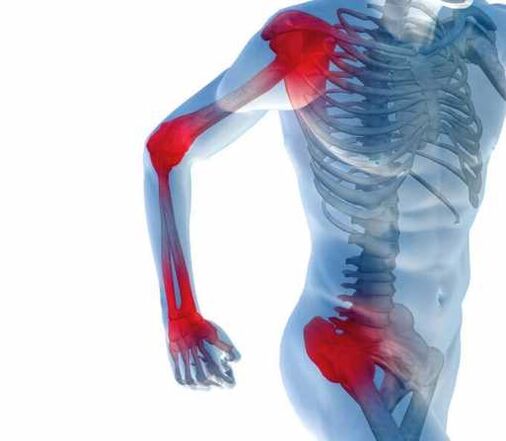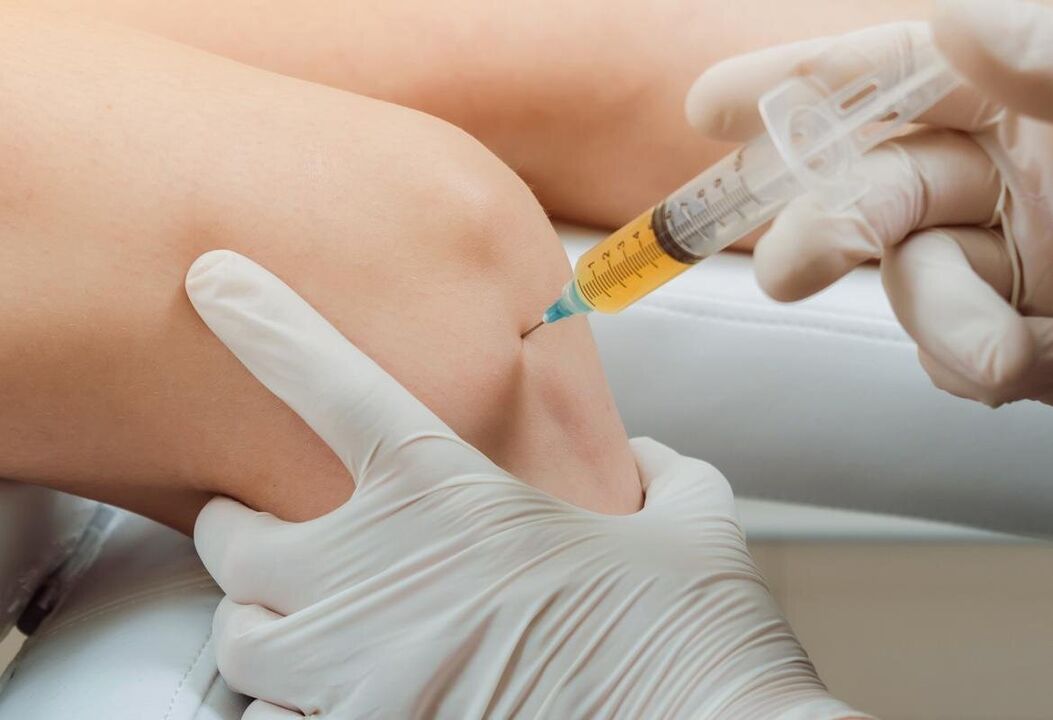
Joint pain(arthralgia) can occur in one or more joints at the same time (polyarthralgia). Arthralgias are observed in rheumatic, endocrine, infectious, tumor, neurological, autoimmune diseases, injuries, overweight. Finding the causes of joint pain is of important differential diagnostic importance; X-ray, ultrasound, laboratory, using invasive methods (arthrosynthesis, arthroscopy). Treatment of arthralgia is reduced to treating the disease that caused it. Symptomatic measures (analgesics, local heat, ointments), immobilization, physiotherapy, surgery are applied.
Classification
Arthralgia differs in its location and depth, the number of joints involved, the nature and intensity of the pain syndrome, daily rhythm, duration of presence, the relationship with a particular type of movement. When there is pain in a single joint, several joints speak of monoarthralgia with simultaneous or sequential pain syndrome - about oligoarthralgia, with the presence of 5 or more joints - about polyarthralgia syndrome.
Due to the nature of arthralgic syndrome, acute and dull pain are different; by intensity - weak and moderately intense; depending on the type of flow - transient and permanent. More often arthralgia occurs in large joints - thigh, knee, shoulder and elbow, less - in the middle and small - wrist, ankle, interphalangeal.
The development of pain in the joints develops with irritation of the neuroreceptors of the synovial membranes of the articular capsules with inflammatory mediators, immune reaction products, salt crystals, toxins, osteophytes. In rheumatology, it is common to distinguish the following types of joint pain:
- caused by toxic syndrome in acute infections;
- primary episode or intermediate (intermediate) arthralgia in acute or recurrent arthritis;
- long-term monoarthralgias of large joints;
- oligo- or polyarthralgia syndrome accompanied by obstruction of synovial membranes or progressive degenerative-dystrophic changes in cartilage;
- residual post-inflammatory or post-traumatic arthralgia in the joints;
- pseudoartralgia.
Why joints hurt
Common infectious diseases
Arthralgic syndrome often accompanies the course of acute infections. Joint pain can be observed both in the prodromal period of the disease and in the early clinical stage, which occurs with fever and intoxication. The infectious form of arthralgia is characterized by "pain" in the joints of the lower and upper extremities, the polyarticular nature of the pain and their relationship with myalgia. Mobility in the joint is completely preserved. Infectious arthralgia usually resolves within a few days as the toxic syndrome caused by the underlying disease weakens.
Infectious arthritis
Possible variants of the development of post-infection reactive arthralgia after acute intestinal or urogenital infections; parainfectious arthralgia syndrome caused by tuberculosis, infectious endocarditis, secondary syphilis. Often the cause of pain in the joints are foci of existing chronic infection - pyelonephritis, cholangitis, adnexitis, paratonsillar abscess or parasitic invasion.
Residual arthralgia becomes chronic or transient after inflammation of the joints. Pain and stiffness in the joints can last for weeks or months; In the future, the well-being and function of the limbs will be fully restored. In the chronic form of arthralgia, its exacerbation is associated with overexertion, meteorological instability and hypothermia.

Rheumatic diseases
Joint pain of poly- or logarthralgia is the main symptom of inflammatory rheumatic diseases. Rheumatic arthralgia is characterized by persistent, intense, migratory pain syndrome, obstruction of large joints, especially the lower extremities, and restricted movement in the joints.
The onset of rheumatoid arthritis, as well as systemic rheumatic diseases, manifests itself in the morning with polyarticular syndrome, which affects the small symmetrical joints of the legs and arms, motor stiffness.
In microcrystalline gout arthritis, arthralgia manifests itself in the form of recurrent paroxysmal pain in an isolated joint, which occurs suddenly, quickly reaches a peak intensity and does not subside for several days.
Degenerative joint lesions
Gradually increasing pain in the joints over a long period of time may indicate deforming osteoarthritis and other degenerative-dystrophic lesions. In this case, the capture of the knee or hip joints is typical; dull, aching, a type of exercise-related pain and their disappearance at rest. Arthralgia can be air-dependent, accompanied by "bumps" in the joints during movement, local attention is weakened when using distraction therapy.
Joint injuries
Kidneys, dislocations of the joints, damage to the garden apparatus, intraarticular fractures are accompanied by severe pain. The affected joint swells, deforms, becomes hot to the touch. The support function of the lower extremities is impaired, movement in the joint is difficult, and sometimes pathological mobility occurs. Injuries can be accompanied by bleeding into the joint space, which causes its stiffness.
Oncological diseases
Persistent oligo- and polyarthralgias (deformities of the nails and distal phalanges, such as "watch glass" and "drumsticks") accompanied by the formation of "Hippocratic fingers" indicate paraneoplastic damage to the synovial membranes. In such patients, oncological pathology of internal organs, primarily lung cancer, should be suspected.
Endocrine diseases
Common causes of joint pain are endocrine disorders - primary hyperparathyroidism, ovariogenic dysfunction, hypothyroidism, obesity. Articular syndrome of endocrine genesis continues in the form of ossalgia, myalgia, oligoarthralgia associated with pain in the pelvis and spine.
Other reasons
Other possible causes of arthralgia are:
- intoxication with heavy metals (thallium, beryllium);
- frequent overloading or microtrauma of the joints;
- long-term drug treatment;
- postallergic reactions;
- straight legs;
- X or O-shaped deformation of limbs;
- pseudoarthralgia, primary ossalgia, neuralgia, myalgia, vascular pathology, psychosomatic disorders.
Diagnostics
Since joint pain is only a subjective symptom, clinical and anamnestic features and physical examination come to the fore when determining the causes of their occurrence. It is necessary to consult a rheumatologist or orthopedist. A number of objective studies are being conducted to differentiate the etiology of arthralgia:
- X-ray of the joints.It is a routine method that allows you to examine any joints during various diseases. Radiography is often performed in one or two projections, it is possible to study in a special style, to perform contrast arthrography. A more detailed description of the condition of the osteochondral and soft tissues of the joints can be obtained by CT and MRI imaging.
- Joint ultrasound.It allows to detect effusion in the joint cavity, bone erosion, changes in the synovial membrane, to measure the width of the joint cavities. The presence of sonography makes it indispensable for the diagnosis of rheumatic joint pathologies.
- invasive methods.According to the instructions, a puncture of the joint, a biopsy of the synovial membrane is performed. In controversial cases, diagnostic arthroscopy is performed, which allows to examine the joint cavity from the inside, to carry out diagnostic and therapeutic measures.
- Laboratory tests.Helps determine the presence of inflammatory processes,rheumatic diseases. Peripheral blood ESR, C-reactive protein levels, uric acid, specific markers of immunopathology (rheumatoid factor, antinuclear antibodies, ACCP) are determined. An important diagnostic method is microbiological and cytological examination of synovial fluid.
- Additional diagnostic methods:thermography, podography.

Treatment
Help before diagnosis
For any pain in the joints, you need to stay calm and do not overload. The metabolic causes of arthralgia dictate the need for a balanced diet, weight normalization. With fresh injuries, it is necessary to apply a cold to the joint, immobilize the damaged joint with a tire or fixation bandage. You can take painkillers or NSAIDs.
Competent examination and neglect of treatment for arthralgia is fraught with the development of irreversible functional disorders of the joints - stiffness, ankylosis, contracture. Since pain in the joints can be a sign of various diseases, it is necessary to consult a doctor if articular syndrome occurs and lasts more than 2 days.
Conservative therapy
The main role in the treatment of joint pain is given to the treatment of the leading pathology. Drug treatment of arthralgia is aimed at stopping inflammatory intraarticular processes and pain. Systemic therapy involves the use of non-steroidal anti-inflammatory drugs.
With moderate arthralgia or contraindications to oral administration of the drug, local external therapy is carried out with warming, anti-inflammatory and analgesic ointments. Applications with dimethyl sulfoxide are applied to the joint area. Articular gymnastics, physiotherapy procedures (drug electrophoresis, magnetotherapy, phonophoresis, UHF therapy) are recommended.
If necessary, periarticular blockades, intraarticular injections of glucocorticoids, chondroprotectors, synovial fluid prostheses are performed. Promising modern therapies for chronic articular pathologies are ozone therapy, joint plasmolysis and orthokinin therapy.
Surgery
Various types of surgery are justified for joint pain resulting from injuries, as well as for chronic diseases that cause loss of joint function. They can be performed by open (arthrotomy) or endoscopic (arthroscopy) methods. Depending on the cause of the disease, the following is done:
- arthroplasty;
- arthrodesis;
- plastic bag;
- rehabilitation of the joint space;
- removal of pathological formations (cysts, intraarticular organs);
- synovectomy;
- joint arthroplasty.






















